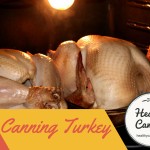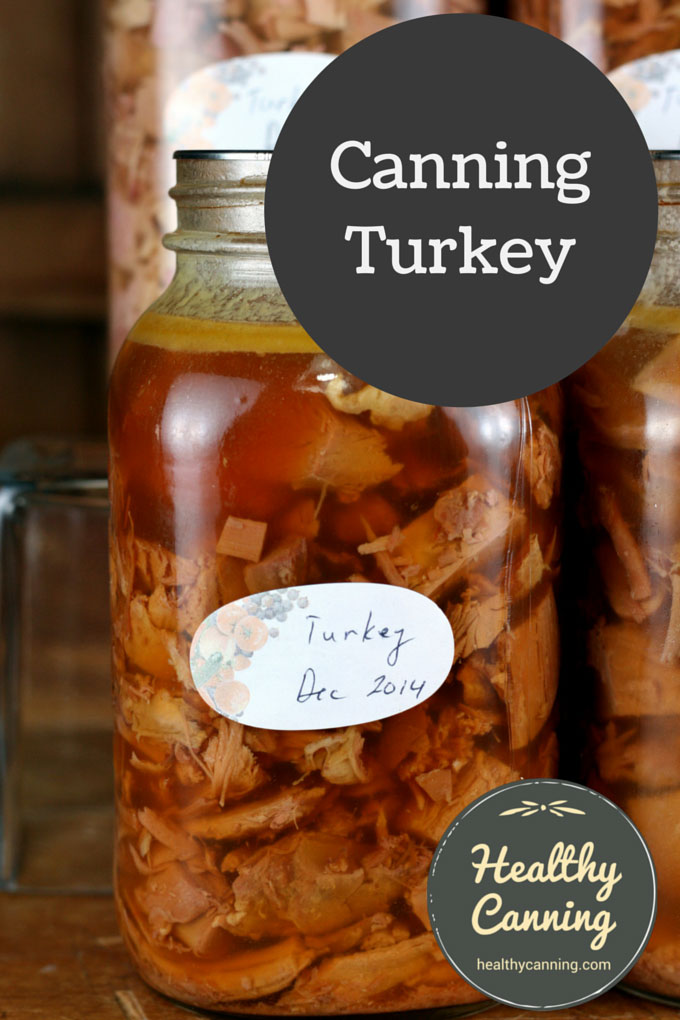You can can turkey in large, whole pieces (aka joints), bone-in or bone-out; or, you can can “turkey morsels”, small cubes and pieces of boneless meat.
The methods for both are similar, but we present them separately below for your convenience.
You can do hot pack, or raw pack. Note that the USDA seems to recommend against raw pack, though: “The hot pack is preferred for best liquid cover and quality during storage. Natural poultry fat and juices are usually not enough to cover the meat in raw packs.” [1] Selecting, Preparing and Canning Meat: Chicken or Rabbit. In: United States Department of Agriculture (USDA). Complete guide to home canning. Agriculture information bulletin No. 539. 2015. Page 5-5.
Uses for boneless canned turkey include: turkey and dumplings, turkey pot pie, turkey à la king, and turkey chunk gravy over mashed potatoes.
Please note that attempting to home can ground turkey is recommended against.
See also: Canning Turkey Stock
Quantities
A 1 litre (US quart) jar of home-canned turkey will yield about 750 g (1 ½ lbs.) of drained, cooked turkey.
A half-litre (US pint) jar of home-canned turkey will yield about 350 g (¾ lb.) of drained, cooked turkey.
Canning turkey pieces, bone-in or boneless
Jar size choices: Either half-litre (1 US pint) OR 1 litre (1 US quart)
Processing method: pressure canning only
Yield: varies
Headspace: 3 cm (1 ¼ inch)
Processing pressure: 10 lbs. (69 kPa) weighted gauge, 11 lbs. (76 kpa) dial gauge (adjust pressure for your altitude when over 300 metres / 1000 feet.)
Processing time: varies based on boneless or bone-in. See recipe.

Canning whole turkey pieces
Instructions
- HOT PACK: Cook meat until about two-thirds done by your method of choice (boil, bake, steam, or pressure cook.) Fill jars with pieces and hot water or broth, leaving 3 cm (1-¼ inch) headspace. OR RAW PACK: Fill jars loosely with pieces of raw meat. Leave 3 cm (1-¼ inch) headspace. No liquid is added.
- Use either half-litre (1 US pint) jars or 1 litre (US quart) jars.
- Optional: per half-litre (1 US pint) jars, up to ½ teaspoon salt; per 1 litre (US quart) jars, up to 1 teaspoon of salt.
- Put lids on, put in pressure canner.
- Processing pressure: 10 lbs (69 kPa) weighted gauge, 11 lbs (76 kpa) dial gauge (adjust pressure for your altitude when over 300 metres / 1000 feet.)
- Processing time without bones: Process half-litre (1 US pint) jars for 75 minutes. OR 1 litre (1 US quart) jars for 90 minutes.
- Processing time with bones: Process half-litre (1 US pint) jars for 65 minutes. OR 1 litre (1 US quart) jars for 75 minutes.
Notes
Nutrition
Processing times for turkey pieces, bone-in
Processing times apply to both raw or hot pack. Processing guidelines below are for weighted-gauge pressure canners. See also if applicable: Dial-gauge pressures.
| Jar Size | Time | 0 to 300 m (0 - 1000 feet) pressure | Above 300 m (1000 ft) pressure | |
|---|---|---|---|---|
| ½ litre (1 US pint) | 65 mins | 10 lbs | 15 lb | |
| 1 litre (1 US quart) | 75 mins | 10 lbs | 15 lb |
Processing times for turkey pieces, boneless
Processing times apply to both raw or hot pack. Processing guidelines below are for weighted-gauge pressure canners. See also if applicable: Dial-gauge pressures.
| Jar Size | Time | 0 to 300 m (0 - 1000 feet) pressure | Above 300 m (1000 ft) pressure | |
|---|---|---|---|---|
| ½ litre (1 US pint) | 75 mins | 10 lbs | 15 lb | |
| 1 litre (1 US quart) | 90 mins | 10 lbs | 15 lb |
Reference information
How to pressure can.
When pressure canning, you must adjust the pressure for your altitude.
What is the shelf life of home canned goods?
Recipe Source
United States Department of Agriculture (USDA). Complete guide to home canning. Agriculture information bulletin No. 539. 2015. Page 5 – 5.
Note: The USDA Complete Guide for Home Canning, in its directions for Chicken or Rabbit on page 5-5 (2015 edition) does not explicitly mention that the method can also be used for turkey. But the Ball / Bernardin Complete does (2015, p. 398), as does So Easy to Preserve (2014, p. 98), and, Clemson Cooperative Extension .
Modifications made:
- Left off raw pack method for turkey morsels, but there is such a method. Refer to USDA directions for that. It would be a nightmare to debone a raw turkey, but, presumably if you had purchased raw boneless turkey breasts you might wish to entertain the idea of the raw pack method.
Nutrition
Varies based on % mix of dark meat and light meat.
150 g (1 cup) white-meat cooked skinless, boneless turkey: 220 calories, 4.5 g fat, o carbs, 41.9 g protein, fibre 0, 97 mg cholesterol, 90 mg sodium. 5 Weight Watchers PointsPlus®
150 g (1 cup) dark-meat cooked skinless, boneless turkey: 262 calories, 10.1 g fat, 0 carbs, 40 g protein, fibre 0, 119 mg cholesterol, 111 mg sodium. 6 Weight Watchers PointsPlus®
* Nutrition info provided by https://caloriecount.about.com
* PointsPlus™ calculated by healthycanning.com. Not endorsed by Weight Watchers® International, Inc, which is the owner of the PointsPlus® registered trademark. Points based on caloriecount nutrition info. Weight Watchers calculator actually gives value of 4 points for both light and dark per 150 g.
Canning turkey giblets, hearts, livers and gizzards
Leave turkey giblets, hearts and livers out of the rest of the turkey meat when canning that meat.
All the old canning books (Kerr 1948; USDA Home Canning Bulletin 242, May 1947; etc.) advised that livers, giblets and hearts should be canned separate from the rest of a chicken or turkey owing to the strong flavour that they would impart during canning to the rest of the meat.
The Putting Food By authors say,
Giblets are more useful if they are canned separately rather than combined in cans of poultry parts (use them chopped in gravies, meat sauces, or spreads, as fillings for main-dish pies, on rice as a supper dish, etc.). Furthermore, the livers are better and handier if they are canned separately from gizzards and hearts; and being so tender, livers need much shorter precooking before Hot packing and processing. Pressure Canning only. Use Hot pack only. Use straight-sided pint jars or No. 303 plain cans.” [2] Hertzberg, Ruth; Greene, Janet; Vaughan, Beatrice. Putting Food By: Fifth Edition. 2010-05-25 p. 166. Penguin Publishing Group. Kindle Edition.
The USDA Complete Guide 2015 is silent on the matter.
The University of Wisconsin Extension Service does have detailed directions on canning gizzards for those interested. See:
Ingham, Barbara, et al. Wisconsin Safe Food Preservation Guide. Wisconsin Safe Food Preservation Series: Meat, Wild Game & Poultry Recipes. B3345. 2002. Page 23.
We don’t know if the advice for canning gizzards extends to giblets, hearts and livers. We’d advise that you contact the University of Wisconsin or the NCHFP to ask for their latest guidance before attempting to can those.
Canning leftover turkey
In general, some people say that they don’t like to can left over meat of any kind. It’s not a safety issue, but a quality issue: they say the meat can end up too dry.
That being said, with freezers already bursting at the holidays and rather than waste it, loads of people do can leftover turkey from Thanksgiving and Christmas, and are perfectly happy with the results.
But this will be a personal taste thing and may also depend on the bird you had to work with and how much dark meat was in the mix to add extra moistness. Remember moistness in meat comes from fat, and the dark meat has a lot of fat in it.
Leftover, canned turkey meat is great used in soups, stews, risottos, etc. Just debone the meat completely, and give it a good second check through for any small bones that eluded you the first time through. It must be done as a hot-pack into jars, with added boiling liquid (broth or water), and processed for the full processing time for boneless turkey: ½ litre (US pint) jars for 75 minutes, and 1 litre (US quart) jars for 90 minutes. Both 10 lbs pressure.
From an 11 kg (24 lb) turkey, on which people ate some white meat but no one touched the dark meat, you can easily expect around 2.3 kg of total meat left, which makes up 4 x 1 litre (US quart) jars full of 2 to 3 cm (1 inch) cubes of mixed turkey light and dark meat.
Cooking with canning
Slow Cooker Turkey and Stuffing from home canning
Turkey, Kale and Chickpea Curry
Further Reading
Luther, Daisy. Canning the Thanksgiving Leftovers. Blog post. 29 November 2013. Accessed March 2015.
References



Julia Hess
Do you add salt when canning your turkey? If so how much?
Healthy Canning
You may. Add up to 1 teaspoon salt per quart, if desired.
Jessica Sims
I deboned and raw packed a whole turkey last week. I didn’t quite fill the jars with meat, but added water to get to 1″ headspace (I was afraid that if I didn’t add water there wouldn’t be enough juice to cover the meat). I then used the carcass for broth and the leftover scraps of meat from that was used for turkey and noodles. I ended up with 3 quarts white meat, 2 quarts dark meat, 2 quarts broth (my pressure canner only holds 7 quarts), and a big pot of turkey and noodles. Last night I opened the first jar of canned white turkey. It was quite good. I used it for a turkey and stuffing casserole.